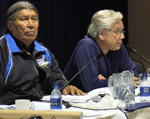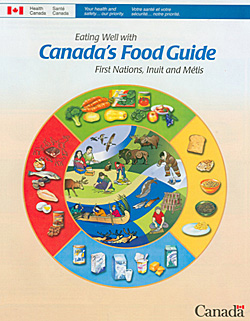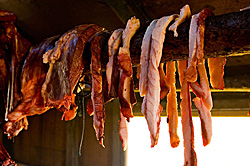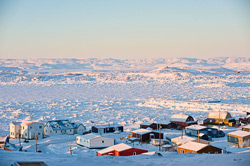Convenience foods, lifestyle changes and global warming are putting Northerners’ nutritional health at risk
The Issue
Soaring diabetes rates, startling increases in cardiovascular disease: the state of nutritional health in Canada’s North is of critical concern. CIHR assembled a panel of four experts, including First Nations leaders and respected researchers in the field of nutrition, to discuss this timely and important issue. What follows is an edited summary of their discussion.
The Panelists

Dene Elder François Paulette
Elder Paulette is an Elder Spokesman for the Smith’s Landing First Nation. In 1971, he became the youngest Chief in the Northwest Territories Indian Brotherhood and has served as Chief in his own community and as the Vice-Chief of the Dene Nation. He lives on the Slave River by the Alberta/Northwest Territories border.

Chief Bill Erasmus
Chief Erasmus is the Assembly of First Nations’ Regional Chief of the Northwest Territories. He is from the Dene Nation and has been a member of the Assembly of First Nations Executive Committee for more than 30 years. He has been the National Chief of the Dene Nation for more than 20 years.

Dr. Harriet Kuhnlein
Dr. Kuhnlein is a Professor Emerita at McGill University in Montreal, and Founding Director of the Centre for Indigenous Peoples’ Nutrition and Environment (CINE). Her research centres on the traditional food resources and health of Indigenous Peoples. She is the author of several books about traditional food sources for Aboriginal populations.

Dr. Eric Dewailly
Dr. Dewailly is Professor of Social and Preventive Medicine at Université Laval, Québec City, and Director of the Public Health Research Unit at the Université Laval Medical Centre.
CIHR: Country foods, also called traditional foods – such as berries, wild game and fresh fish – are nutritious and beneficial to health. Harvesting these foods promotes active living, good health and a direct connection to the land/food source. But many studies have shown a general drop in the amount of country food in Northerners’ and Aboriginal Peoples’ diets. What are the challenges to hunting, fishing, gathering and harvesting in 2009, given changing lifestyles and dietary habits?
Elder Paulette: I live out in the country; I don’t live in the town. I live by a beautiful river. And most of the food that I eat here is probably buffalo, moose and caribou. I’m a hunter. I’m from a hunting culture.
CIHR: Are those skills passed on to the next generation?
Elder Paulette: In my family it is, very much so. Most of my boys and my nephews hunt buffalo and moose. This winter they went out for caribou. We try to exercise and practise that. That way of life. And lots of birds: fowl, ducks and geese. Fish, too. … The only thing is that the river is getting polluted..The climate change is changing the whole habitat of mammals, and so on. So, you don’t really know what’s going to happen from year to year
CIHR: Chief Erasmus, what’s your take on the transition away from traditional diet of country food and the traditional skills of hunting and gathering?

Chief Erasmus: I think many of our people still eat our foods. If you ask them which foods they prefer, they generally prefer our own foods. But it’s evident over the last few years, there’s a huge trend towards Western foods. And it’s happening globally, for a number of reasons. But one of the concerns that we have is we have worked hard with the Canadian Government on recognizing that our foods are nutritious. But having access to those foods is another thing. Canada put our foods on the Canada Food Guide for over a year now. But if you don’t have access to those foods, then you don’t get them in your diet. And what I mean is, for example François Paulette is talking about those foods getting polluted. For example, if our local communities don’t work closely with development, if they are not directly and fully involved, then a particular development might take place on our land and prevent us from getting to the caribou. If you allow a mine to be developed where the caribou normally migrate, then that might change their pattern and people won’t have access to food. So, there are a number of factors at play.
CIHR: Dr. Kuhnlein, you have done studies on lifestyles in the North. What have you seen?
Dr. Kuhnlein: When we do systematic evaluations of what people are eating, there is a decline in traditional foods. And there is also an increase in factors that predispose chronic disease that relate to changes in diet. For example, there are increases in unhealthy body weights and obesity, more and more cancer and diabetes. It’s creeping up. And it’s not just Canada; it’s throughout the world – we see it in many different places. But it’s all related to changing lifestyles. So, it’s quite a concern for people to think about: what are the risks of losing the cultural food patterns and lifestyles? What are the risks to their health, and what should be done to try to recapture some of the healthy things in peoples’ lives?
“The packaged food is full of trans fats, etc. I can see two big angles. One is how to promote, as much as possible, in terms of accessibility and youth training and willingness, the use of local food. The other side is how to restrict, ban or act on the quality of the imported food.” Dr. Eric Dewailly
CIHR: Dr. Dewailly, what are your views on this?
Dr. Dewailly: It’s difficult to generalize from one experience with one group to the entire Aboriginal groups. Each story is different. But there is certainly some commonality between not only small groups in Canada but everywhere in the world. What is still unclear for me is the shift. Is it a generational shift or an age shift? In other words, many believe that the young people, when they’re married and they build their new families, they will go back to the old food. But some of them will not. In other words, if you look only at teenagers, maybe you will have a false picture, because it’s more the age than the generation. So, we still don’t know. But, anyway, for sure there is a decline. I worked for many years in the South Pacific and it is the same. The people are eating less fish. Modernization means having easy-to-use food, in terms of the time you have to cook it, etc. So, there is something that is really worldwide. And, as Harriet says, it has a lot of consequence because available imported food is not often very good quality. The packaged food is full of trans fats, etc. I can see two big angles. One is how to promote, as much as possible, in terms of accessibility and youth training and willingness, the use of local food. The other side is how to restrict, ban or act on the quality of the imported food. Both angles are important.
CIHR: Elder Paulette, you do a lot of hunting and eat locally available foods. Do you get to Fort Smith for shopping at the stores? Is Southern/Western food having much of an impact on your life?
"There are a lot of Indian kids that would not eat wild food. That comes with colonization. They figure that wild food is inferior to white man’s food.” Elder Francois Paulette

Elder Paulette: I tend to balance it out. Every week, I batch up a whole tray of fruit salad for my family, so they have that in their breakfast. But I think that most of the style and the habits of indigenous people eating their food is it comes from the home. You teach this to your children. You don’t discriminate what food you’re eating. You don’t ask what you’re eating. I was in a store a couple days ago, and I asked the girl at the till, ‘Do you eat wild food?’ ‘No, I don’t eat wild food,’ she said. So, there are a lot of Indian kids that would not eat wild food. That comes with colonization. They figure that wild food is inferior to white man’s food. It comes with assimilation and colonization. Studies should be done on that, particularly on colonization. It deals with health. So, health would be colonized. To be colonized becomes a huge responsibility of the families and the leadership to do that. Everybody wants a quick fix. If you work in a mine, people come home, they want everything that’s fast. All those people working on the tar sands, the foods they’re eating must be incredibly rich in fat. They come home and they want a quick fix. People starting to get into the workforce, that’s all they think.
CIHR: Is there not pride in hunting and trapping and eating your own food? Is that being lost?
Chief Erasmus: Yeah, there is, but Francois is right. Some people, depending on how they were brought up, don’t have those foods, they don’t eat them. That’s a reality we have to work with. We haven’t done solid research on it, but from my own observation it seems that some of our younger people, they go through a period of time when they don’t want to eat country food, but as they get older, they do.
CIHR: Dr. Kuhnlein, you were involved in a project with the people of Fort McPherson, NWT, to try to raise the profile of country food. That did succeed, did it not? A food and health book (cookbook) was produced and people began talking about their own foods again.

Dr. Kuhnlein: Yes, we’ve been doing this in a couple different places. But Fort McPherson in particular took the ball and ran with it. They did a lot of media, local radio, to get people talking about local, cultural, traditional foods, how to prepare them, and how to share that information. And they did put this into a little book, which is really quite attractive and popular in the community. But it’s interesting, because they decided to do these recipes together with health messages, like ‘Don’t put too much sugar in your coffee’ or ‘Be sure to exercise.’ They really did like that kind of orientation to changing health behaviour. I mean, it’s not all communities that like to get on the Southern health education bandwagon in the standard mode. Following up on the comment by Francois, this kind of colonization is very important to watch out for in the health education messages, as well as paying attention to how food patterns have changed because of the media. You mention Kentucky Fried Chicken. Sure it’s there. But it’s also on the media. It’s the food industry that’s capitalizing on the taste buds that want that fat, that want that salt, that want that sugar, without incorporating their traditional way of taste. It’s very complicated when you think about how to really permanently change a community’s dietary patterns if they’re on the track of more and more Westernization. I think it can be done. It just takes good strong leadership, and people that are committed to the cause right there on site.
CIHR: What about the cost? Fresh food – fresh vegetables and fruit – is very expensive in the North, is it not? Is that an issue?
Chief Erasmus: Food that is brought in is quite expensive, but thinking about what I’m hearing – there are a lot of people that are doing things. Like people make stir fries, but instead of using beef or pork they use caribou or moose meat. People make shepherd’s pie and they’ll grind up caribou meat. People are mixing their recipes to accommodate what they want on the table. But there really isn’t as much of our own foods as we would like. And it’s proven that it’s more nutritious.

Dr. Kuhnlein: About the cost of food – there’s no two ways about it. The food in the stores in the North is two to four times more expensive than it is in Montreal supermarkets. So, when people don’t have a lot of money, they really question whether they want to buy fresh broccoli, or whatever. Recently, with the food price crisis globally, the prices are even getting worse… It’s a problem to try to encourage people to eat good quality Southern food. With the incomes that they have it’s not easy to access it. Of course there are government programs like the Food Mail Program and other things. But I’m sure that Elder Paulette and Chief Erasmus can talk more about why the prices are really a problem for people to buy good, healthy Southern food. And that’s why they need as much access as possible to good quality traditional food.
Elder Paulette: The season also dictates the prices. The other thing is that in the summer, in my part of the world, it’s a very good climate for gardens. And there are people trying to get into that, and that lowers the cost of fresh vegetables. Or you could even extend potatoes by preserving them in the fall. So, that helps a lot, but it takes a lot of work to maintain a garden. You’ve got to till it and weed it, and so on. It’s part of the decolonizing process and people need to begin to do that. You talk about what happened at Fort McPherson, that to me is a form of people decolonizing themselves. That takes a lot of work and leadership to help in that process.
CIHR: We mentioned earlier the effects of global warming and climate change. Animals’ foraging habits and migratory routes are shifting. Are you seeing a lot of that?
Elder Paulette: To give an example, in the fall when you’re hunting moose here now… September a few years ago would be when you’d get a moose, when the rutting season began. So, people spend most of September hunting and they don’t see anything, because the season’s now one month behind. You go in October and you can get a moose. People go in September, they get discouraged, and they go back to food from the store. So, people have to understand the patterns of the weather, and how this is changing. But I live right by the river, and I travel it all the time, I can see the changes, and I’m listening to what is happening to the land. Most people don’t do that.
“People spend most of September hunting and they don’t see anything, because the season’s now one month behind. You go in October and you can get a moose. People go in September, they get discouraged, and they go back to food from the store.” Elder Francois Paulette
CIHR: Dr. Dewailly, what about your experiences in the North, and the impact on Inuit? Not to diminish the impact of global warming in other areas, but in the North it’s quite real.
Dr. Dewailly: Yes, but at the same time we have a feeling that these people have had to adapt, in the past centuries, to such difficult conditions that compared to change due to the modernization of their life, it’s really nothing… I don’t want to be incorrect in terms of political incorrectness. I’m just saying that (the people) there, especially the elders, are saying, ‘Well we’re used to having change in the climate and we’re used to, for a long time, having to adapt ourselves. This is something we can do. We are not afraid of that. What we don’t know is the issue of the new generation.’ They are really more afraid of that. Even though in the public discourse that’s not the case. I’m not saying it (climate change) is not a problem. I’m just saying that they are relatively confident that they will adapt because they are used to adapting for a long time to any difficult condition of life. I think that TV and everything is changing the society really much more than (the effect climate change) is having on daily life
Chief Erasmus: My concern with climate change is that we’ve always been able to survive, but things are happening at a very rapid rate. We’re finding permafrost is melting, and it’s got a huge impact in the North. There’s discussion now of wanting to build a pipeline from the Beaufort Sea to the South. And we’ve never encountered the rapid melting of the permafrost. I’m not sure if they can build it, because of that. There’s a whole number of things. Climate change is real. It’s happening. The Earth is warming. And we’re told that at the Equator, if it warms up two degrees more there, it is warming eight degrees where we are on top of the world. Yes, we can adapt, but what is the rest of the world doing? And that’s what we need to be concerned about. We need to put a lot of thought into that and make change happen.

CIHR: What about the contamination of the food supply? Because of ocean currents and winds, the North is a magnet for atmospheric and oceanic pollution and contamination. There are significant threats to the aquatic food chain through organochlorines and heavy metals. How serious is the threat?
Dr. Dewailly: I have been working since 1985 on this subject and I would say that 24 years later, probably all of this information, science, money – we know where they (the contaminants) are coming from, we know for most of them what is the toxicity. We know which groups are more hazardous than others – plenty of work has been done. At the same time, some indirect consequence of that is probably to make the image of that food for some people as poisonous, etc. So, at the same time you say they’re nutritious, you say, ‘We’re putting $10 million to work on contaminants.’ For the family, it’s not so easy to understand and to balance the messages. But I feel that, today, we have a very clear picture about the situation. In some cases, advice has been given, especially with pregnant women. But overall, scientists, everybody agrees it’s much better to eat country food, even if there is some contamination.
CIHR: What are the major challenges to good nutrition in the North, and what do you see as the solutions?
Dr. Kuhnlein: I think, first of all, we have to recognize there is still a lot of work to be done. A lot more research, but also community action. Research can only take us so far. If you want to make a change, of course there can be research on how to change people, but there’s no doubt about it: we’re at the stage where we need to really step up community-level education in partnership with the community people. There needs to be lots of communication so that community people understand the issues. But they’re the people who need to make the decisions about what are the best avenues for education activities at the grassroots level. From that point of view, (we need) to have partnerships between researchers and government and the community to develop reasonable education initiatives. But this takes a lot of resources. You’re talking about people on the ground, who can implement behaviour change or attitude change, and it also means getting good food that is accessible to people… decent food in the stores at prices that people can afford. Also, so that there is a traditional food that people can access, not only on the land, but that they can also buy at the store. Which is not the case in all parts of Canada. Native people can’t buy their traditional foods, because their local stores can’t sell their traditional food because of complicated government regulations on how the food is inspected. So, that’s what I think should be happening. The First Nations and Inuit Health Branch have the Food Security Reference Group, that’s a good place to start in building education and to try to get resources so that communities can take action to build their own lives the way they want.
“If you want to make a change, of course there can be research on how to change people, but there’s no doubt about it: we’re at the stage where we need to really step up community-level education in partnership with the community people.” Dr. Harriet Kuhnlein
Chief Erasmus: I think part of what makes it happen is there needs to be recognition of the economy of hunting and trapping and fishing and gathering, so that they can be put in the common economy of today. If more of our people were encouraged to continue hunting and trapping for example, you’d have young adults coming out of high school having that as an option, so that they learn it as a business. Because that’s what it is – it’s a small business. And it enables them to take that on as part of a way of life. You’d find more of our people on the land and more of our people continuing to exercise their culture. So, I think that’s something we seriously have to look at. For many years, there was a push to have our young people go to college and to university. And to some extent that works, but not everyone wants to do that. Now there’s an attempt to get people into different trades and this sort of thing, of looking at the economy. I think we have to go through that exercise. The other thing is that Canada has to play a leading role on an international scale. Canada has not endorsed the Kyoto protocol, which has a huge impact and effect on global warming and climate change. The tar sands, for example; they have been very lax in taking that to a point to where will be no extension of the tar sands until stricter standards are met. People downstream from the tar sands are very concerned about finding many changes… in fish, the water quality and so on.
“If more of our people were encouraged to continue hunting and trapping for example, you’d have young adults coming out of high school having that as an option, so that they learn it as a business.” Chief Bill Erasmus
Dr. Dewailly: It seems to me that there’s still a lot of research to do on this hunter and gatherer diet – what the benefits of that are. Because it’s still it’s something we don’t really understand. … We also need to move to evaluation of interventions that work in the community and see the external validity: how it can be exported to other communities. I’m thinking about things like the ban of trans fats, which is being conducted in Nunavik, today certainly could be extrapolated to other communities. But we need to know if it works. I’m working with the Cree Board of Health and Niskamoon Corporation (who have) fish restoration projects, where they put money towards a family going into the bush and fishing for months. And then they go back and there is an economy around the fish. I would really like to do a health evaluation project looking at the family before and when they return, just to see the impact on their fitness and their cardiovascular risk factors and mental health. This kind of evaluation has not really been done. So, everybody has some story, some experiments, and some intervention that has been done. But we don’t really know what has been working well, and what could be a lesson for other groups. I would really like to evaluate if, today, one community receives all fruits and vegetables and all good foodstuff from the South at the same price as in the South… What would happen after six months? … This is one way to see what would happen after six months or one year in the health of the community. My point is it may be time to see to see what is really working, and what is not working.

CIHR: Elder Paulette, you have the final word. What do you think are the challenges and solutions?
Elder Paulette: It’s a lot of work. It’s balancing out the whole view of the world, not just physically, spiritually. Because much of the animals and fish that we use, they’re all spiritual entities. And how people use them not just for food and diet, but the spiritual part of that, and we have lost that. Many communities have lost it. I just want to extend what Chief Erasmus said – there is no monitoring of the water here. Right now the river here is down by 40% since 1971 and that says a lot about toxins in the water. So, what are the effects of that on the fish? And on the feeding of moose and caribou? There’s a lot of work that needs to be done. If you’re going to do research, you’ve got to do research on the specific areas with water, because water is life and we need to know the effects on wildlife, and it carries on to us. It’s important because we can’t change people, people need to change themselves. But you need to let them know what is positive, and tell them that if there’s something wrong with eating the food… you’ve got to tell them that. Or the people will continue to eat the fast food and quick fix and so on.
- Date modified: